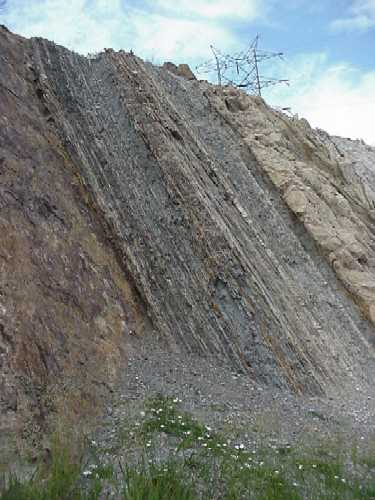Rock Types and the Rock Cycle
There are three basic rock types. This classification
is based on how they are formed:
-
Igneous
-
Sedimentary
-
Metamorphic
Igneous Rocks
-
Formed directly from cooling magma (mainly), but may also be grown from aqueous
solutions at or near a magma chamber
-
pegmatite has large crystals because, in water, the mineral ions are
able to quickly find and crystallize to similar types
-
Composition of magma varies and this effects the composition
of the rock
-
High silica content = very viscous magma (honey) = granite
-
Low silica content = low viscosity magma (melted butter)
= basalt
-
Rate of Cooling effects size of the crystals formed
-
Slow cooling in Intrusive (plutonic) rocks (big crystals)
= granite
-
Faster cooling in Extrusive rocks (smaller crystals) = rhyolite
-
Very fast cooling = no crystals (glass) = obsidian
-
Magma also has gasses in it (usually at great pressure)
-
1- 5 % of total weight
-
They provide the pressure to help the magma force itself
to the surface
-
mostly water vapor
-
carbon dioxide
-
some nitrogen
-
some sulfur
-
These gasses were the source of the earth's early atmosphere
-
Gasses explode violently out of viscous magma
-
Mount St. Helens in 1980 (Washington State)
-
Gasses quickly bubble (gently) out of magma with low viscosity
-
When gasses escape magma, it is called lava
-
Examples are:
-
Granite
(intrusive ... big crystals ... cooled very slowly)
-
Rhyolite
(extrusive ... smaller crystals ... cooled quicker)
-
Obsidian
(glassy texture .... cooled very quickly)
-
all these rocks (above) have the same chemical composition
but formed under different conditions.
-
Basalt
(oceanic crust and moon rocks)
-
It is possible to "date" igneous rocks using radiometric
techniques (radioactivity).
Sedimentary Rock
-
Common Examples:
-
Sandstone from sand
-
Shale (most common sedimentary rock) from silt/clay (mud)
-
Conglomerate from gravel
-
Coal from fern trees
-
Limestone from marine animals (coral, snails, clams, etc.)
-
Dolomite
is a sedimentary rock and may be considered an altered form of limestone
(but slightly harder and denser), the carbonate fraction being, calcium
magnesium carbonate [CaMg(CO3)2]. Dolomite formations
are widespread and are notable in the region of the Alps called the
Dolomites,
where the rock was first studied. The south - eastern
bedrock
of Wisconsin is mainly Silurian dolomite (laid down 417 - 443 million
years ago in shallow seas... when plants first emerged on land and fishes
dominated the seas).
-
Salt (halite) from evaporation
-
Type of particles (in sedimentary rock) give clues to the
environment in which it formed
-
Difficult to "date" sedimentary rocks using radiometric techniques
Click
here
to see all kinds of sedimentary rocks.
Metamorphic Rock
The Rock Cycle
Study the diagram below. You will see that nothing lasts forever on this earth (not even
rocks). The rock cycle shows us that given enough time, rocks
form, they break up, they reform, they get transformed. This is hard for
us to imagine because a human lifetime is almost nothing to a rock.

-
This chart shows us that nothing stays the same
-
Rocks can change from one type to another in many different
ways
-
This is a very slow cycle (taking millions or billions
of years)
-
The earth must be very old!
ŠJim
Mihal 2004, 2006 - all rights reserved


